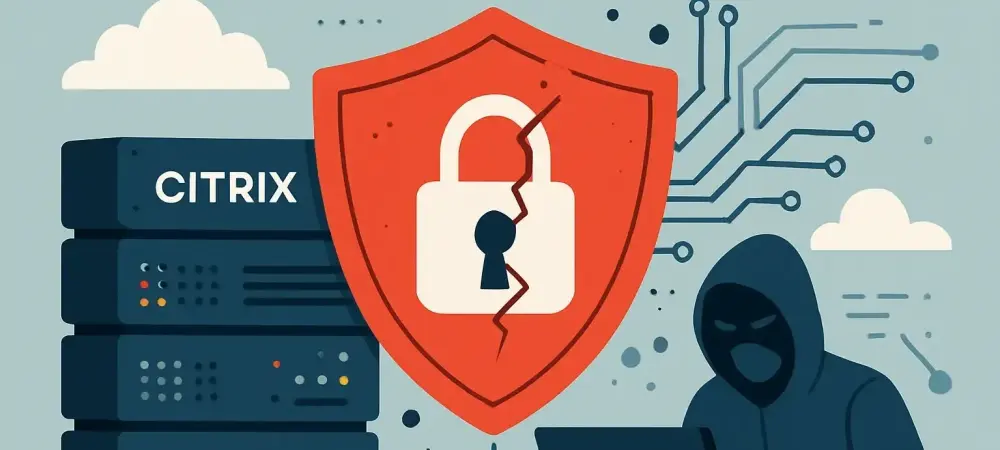Over 2,100 Citrix NetScaler servers continue to face substantial vulnerabilities, posing an active threat to cybersecurity despite the availability of patches. Identified as CVE-2025-5777 and CVE-2025-6543, these vulnerabilities have been exploited since mid-June 2025, allowing unauthorized access through authentication bypasses and session token theft. According to cybersecurity experts at ReliaQuest, scanning activities related to these vulnerabilities began on June 19, revealing numerous unpatched IP addresses, particularly in the United States and Germany. This highlights a significant security risk given the alarming extent of these vulnerabilities.
Understanding CVE-2025-5777
Citrix Bleed 2 and Its Implications
CVE-2025-5777, also known as “Citrix Bleed 2,” poses a critical threat due to its failure in input validation, culminating in out-of-bounds memory reads that leak sensitive authentication data. This vulnerability allows session tokens, which are crucial for API calls and persistent application sessions, to be hijacked. Such tokens can be exploited beyond the user’s browser session termination, raising significant concerns for prolonged unauthorized access. Experts have observed advanced attack patterns, suggesting involvement by sophisticated threat actors who manipulate tactics like Multi-Factor Authentication (MFA) bypasses and session token reuse across various IP addresses, adding complexity to the threat landscape surrounding Citrix NetScaler.
Cybersecurity Strategies and Observations
The exploitation of CVE-2025-5777 necessitates a robust cybersecurity strategy to safeguard sensitive data and maintain system integrity. Organizations must be vigilant, closely monitoring network activities for anomalies linked to this vulnerability. This includes deploying effective input validation measures and routinely updating security protocols to mitigate potential exploitations. Analysts have noted attackers utilizing advanced tactics, challenging security teams to detect and neutralize these threats efficiently. Emphasis is on fostering proactive security measures, such as enhanced monitoring and adaptive defenses that address emerging threats promptly, thereby protecting assets against sophisticated exploits.
Addressing CVE-2025-6543
Understanding Memory Overflow Risks
CVE-2025-6543 presents its own set of challenges with a CVSS score of 9.3, suggesting severe vulnerabilities impacting Citrix NetScaler servers. This flaw, actively exploited by attackers, leads to memory overflow conditions that can induce denial-of-service states, endangering critical network infrastructure. ReliaQuest analysts have noted intelligent tactics, including domain reconnaissance via tools like Microsoft’s “ADExplorer64.exe” and obscure techniques using VPN services meant for consumers. Organizations affected by these vulnerabilities must understand the risk profile of CVE-2025-6543, adapting their cybersecurity measures to address memory overflow weaknesses effectively.
Tackling the Threat Landscape Strategically
Confronting CVE-2025-6543 demands a strategic approach to cybersecurity, ensuring network resilience amidst potential exploitations. It is imperative for organizations to deploy updated security solutions, focusing on protecting network infrastructures from denial-of-service conditions or other exploitative measures. Analysts suggest utilizing advanced detection tools to identify threat patterns typical of this vulnerability while deploying efficient countermeasures to neutralize potential impacts. Citrix’s proactive response in releasing updated NetScaler builds is a critical step, yet organizations must bolster these efforts with tailored security protocols, ensuring their systems remain robust against future exploitations.
Citrix’s Response and Recommendations
Applying Updated NetScaler Builds
Citrix has responded swiftly to these vulnerabilities by releasing updated NetScaler builds that directly address the concerns posed by CVE-2025-5777 and CVE-2025-6543. The essential patched versions include NetScaler ADC and NetScaler Gateway 14.1-43.56 and later, as well as 13.1-58.32 and subsequent releases of 13.1. By applying these patches, organizations can significantly enhance their security posture, mitigating potential exploits that threaten system integrity. However, Citrix has underscored the importance of terminating active sessions following patch applications to prevent attackers from leveraging compromised tokens, while urging organizations to upgrade older NetScaler versions that are no longer supported.
Ongoing Security Measures
To maintain a secure environment, Citrix emphasizes integrating comprehensive security practices into organizational operations. These measures include consistent monitoring of network activities and implementing periodic reviews of security infrastructures to ensure they are aligned with current threat landscapes. Organizations must be proactive, recognizing the importance of updating their systems as vulnerabilities surface. Such ongoing security vigilance serves not only to protect sensitive data but also to fortify defenses against attackers targeting corporate applications and remote access solutions for breaches.
Urgent Considerations for the Future
Over 2,100 Citrix NetScaler servers remain vulnerable to serious security threats despite the availability of patches designed to eliminate these risks. The specific vulnerabilities, identified as CVE-2025-5777 and CVE-2025-6543, have been actively exploited since mid-June 2025. These exploits constitute a major threat, allowing cyber attackers to bypass authentication systems and steal session tokens, thus gaining unauthorized access to sensitive information. Expert analysts at ReliaQuest have noted a surge in scanning activities for these vulnerabilities, starting on June 19. This scanning identified numerous unpatched IP addresses, with a particularly high number located in the United States and Germany. The prevalence of these unpatched servers underscores a critical security risk, as these vulnerabilities are alarmingly widespread. The situation calls for urgent attention to ensure that organizations act swiftly to apply the necessary patches and secure their systems against potential cyber attacks.

